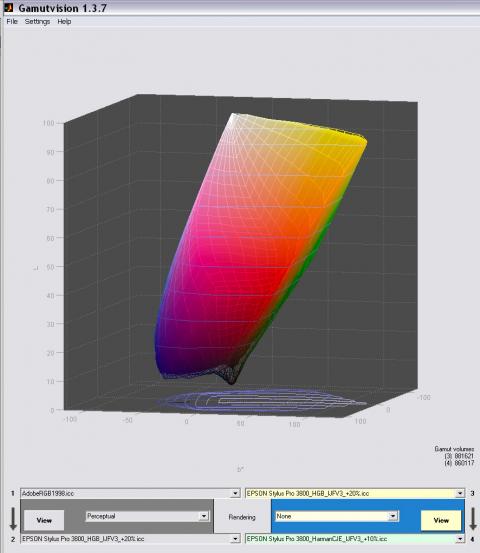- Thread starter
- #111
- Joined
- May 29, 2007
- Messages
- 2,982
- Reaction score
- 1,715
- Points
- 313
- Location
- Ghent, Belgium
- Printer Model
- SC-900 ET-8550 WF-7840 TS705
An update today: finally after 17 cleaning cycles over a period of 36 hours I managed to have a almost 100 % complete nozzle check (some minor ones in the magenta/light magenta but I don't think this will influence printing negatively).
Not sure what is causing the behaviour. I did not shake the bottles heavily before I fill the cartridges: just swirling the bottles lightly. I agree with Irv Weiner, this has to be improved. Leo Chang says 3-5 cleaning cycles should be enough to flush the lines enough and get it properly purged. I ended up with more than 3 times as much cleaning cycles. Happily the auto reset chip on the maintenance cartridge helped to alleviate me the need to purchase another waste ink tank, as the massive amount of cleaning cycles would have filled up the maintenance tank completely.
I think for the smaller Small Foot cartridges to be reviewed by Irv Weiner should have the refill hole on the top, combined with the always full indicating chips on top of them, it would making refilling much easier. You will not need to remove the cartridges to refill, as the repetitive insertion and removal of these rubber based ink outlet valve cartridges will impair its longevity negatively.
A most important claim of the Inkjetfly system is the quality of its IMA 24/36 pigment ink, which should yield a larger gamut compared to other refill inks, including to the original Epson K3 ink. This is quite a claim, so let's have a look at it. Before doing this, I created dedicated profiles for my favourite cheap glossy photo paper: Aldi's SihlX 280 gsm high gloss photo paper.
I already made profiles for this paper for the original Epson K3 inkset (in my early days, when I was still using the original ink), the first refill ink I used: Image Specialists IM-K4 and the Inkrepublic IRK4-nano. So I will compare these inks.
So this is the result combined with the online ICC viewer website: www.iccview.de (german/english).
Original Epson K3 versus Inkjetfly IMA 24/36:
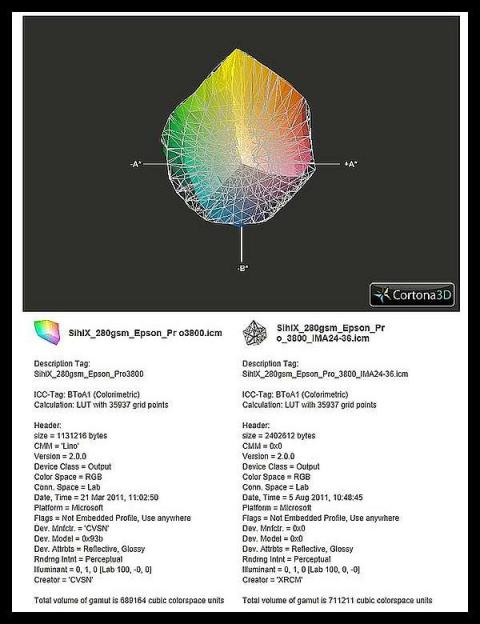
Image Specialists IM-K4 versus Inkjetfly IMA 24/36:
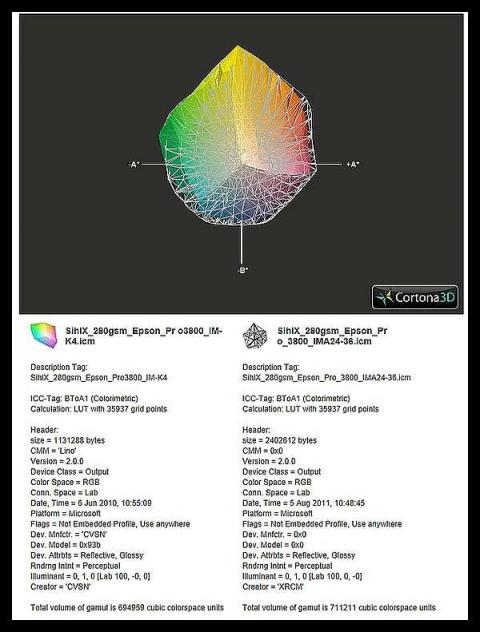
Inkrepublic IRK4-nano versus Inkjetfly IMA 24/36:
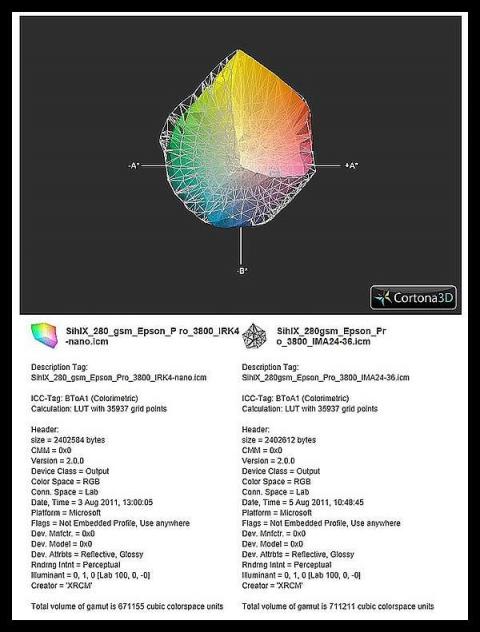
Conclusion: Inkjetfly's claim having a larger gamut compared to any other refill ink and even to the original Epson K3 ink is true. Very well done indeed for an aftermarket refill ink. Image Specialists IM-K4 also has a very good gamut, but the problem with this is ink is the lack of gloss, giving the prints a rather muted impression, especially on glossy papers. The 3 other inks are much more glossy. Inkjetfly IMA 24/36 and IRK4-nano have similar gloss and the best gloss is still the original Epson K3 ink.
The differences with Epson K3 as basis (100 %) are for Image Specialists IM-K4 +0.84 % better, for Inkrepublic IRK4-nano -2.61 % worse, Inkjetfly IMA 24/36 + 3,20 % better. Despite the larger gamut of the Image Specialist IM-K4 ink, the Inkrepublic IRK4-nano ink yield better and more pleasant prints to the eye, due to the much improved gloss level and better Dmax for the photo black (see earlier posts) which helps to increase contrast and thus the perceptual quality of the prints.
What about the neutrality of the ABW mode printing true black and white printing ? This mode will use the 3 blacks and includes Light Magenta, Light Cyan and yellow to counter the warm glow of the K3 inks. The interaction of K3 (3 blacks) and the lighter colours is very critical and also depends on the paper used to yield the most neutral B&W prints. This is the most important litmus test if an aftermarket ink manufacturer has done his job well.
Have a look at the picture below, shot with a gray card as reference to compare the neutrality of B&W print.
There are 3 prints, printed with the following inks on the same paper: Aldi's SihlX 280 gsm and the ABW-mode (setting: neutral, tone: dark) for picture 1 and picture 2. Picture 3 is done by first processing the image to gray scale and printing with the Inkjetfly IMA 24/36 inkset with dedicated profile with gray ramp correction (Colormunki 3 sheet profile).
1. Inkrepublic IRK4-nano (ABW-mode)
2. Inkjetfly IMA 24/36 (ABW-mode)
3. Inkjetfly IMA 24/36 (colour mode, image converted to gray scale, printed with dedicated profile with gray ramp correction)
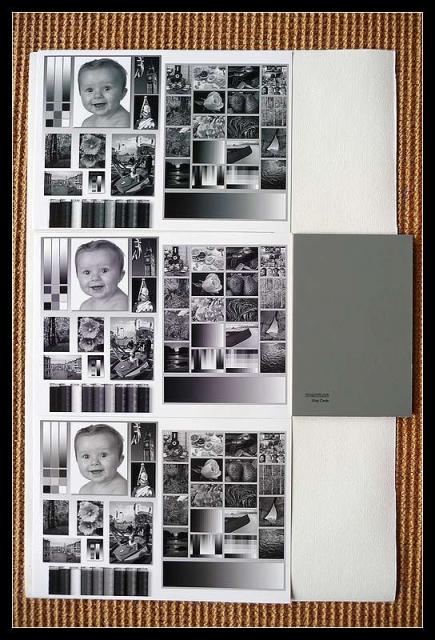
As you can see: the Inkrepublic IRK4-nano has slight greenish cast on the prints (as stated by the Inkquisitor website, but not as heavily), the Inkjetfly IMA 24/36 definitely a purplish cast and the most neutral and the best to my eyes is the 3rd version printed in colour mode with a dedicated profile, albeit with a slight yellowish cast. When I used the Image Specialists IM-K4 inkset I also experienced the same purplish cast with the ABW-mode as with this Inkjetfly IMA 24/36 ink set. Is is this a problem: yes if you insist on neutral prints, but one can use the colour wheel in the ABW mode to counter the cast with the opposite teint. Please note: the ABW mode is optimized for Epson own proprietary papers and might not work well with other brands of photo paper, so using the colour wheel is obligatory to counter these types of colour casts.
So this picture at the end, that a well created profile will give you very similar prints with different inks. On the left: Inkrepublic IRK4-nano and on the right: Inkjetfly IMA 24/36.
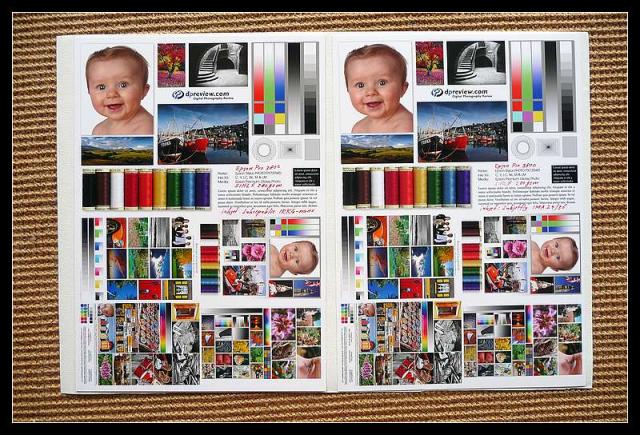
I hope others (Irv Weiner) will pick up this topic and write down his experience with his small foot system.
Not sure what is causing the behaviour. I did not shake the bottles heavily before I fill the cartridges: just swirling the bottles lightly. I agree with Irv Weiner, this has to be improved. Leo Chang says 3-5 cleaning cycles should be enough to flush the lines enough and get it properly purged. I ended up with more than 3 times as much cleaning cycles. Happily the auto reset chip on the maintenance cartridge helped to alleviate me the need to purchase another waste ink tank, as the massive amount of cleaning cycles would have filled up the maintenance tank completely.
I think for the smaller Small Foot cartridges to be reviewed by Irv Weiner should have the refill hole on the top, combined with the always full indicating chips on top of them, it would making refilling much easier. You will not need to remove the cartridges to refill, as the repetitive insertion and removal of these rubber based ink outlet valve cartridges will impair its longevity negatively.
A most important claim of the Inkjetfly system is the quality of its IMA 24/36 pigment ink, which should yield a larger gamut compared to other refill inks, including to the original Epson K3 ink. This is quite a claim, so let's have a look at it. Before doing this, I created dedicated profiles for my favourite cheap glossy photo paper: Aldi's SihlX 280 gsm high gloss photo paper.
I already made profiles for this paper for the original Epson K3 inkset (in my early days, when I was still using the original ink), the first refill ink I used: Image Specialists IM-K4 and the Inkrepublic IRK4-nano. So I will compare these inks.
So this is the result combined with the online ICC viewer website: www.iccview.de (german/english).
Original Epson K3 versus Inkjetfly IMA 24/36:

Image Specialists IM-K4 versus Inkjetfly IMA 24/36:

Inkrepublic IRK4-nano versus Inkjetfly IMA 24/36:

Conclusion: Inkjetfly's claim having a larger gamut compared to any other refill ink and even to the original Epson K3 ink is true. Very well done indeed for an aftermarket refill ink. Image Specialists IM-K4 also has a very good gamut, but the problem with this is ink is the lack of gloss, giving the prints a rather muted impression, especially on glossy papers. The 3 other inks are much more glossy. Inkjetfly IMA 24/36 and IRK4-nano have similar gloss and the best gloss is still the original Epson K3 ink.
The differences with Epson K3 as basis (100 %) are for Image Specialists IM-K4 +0.84 % better, for Inkrepublic IRK4-nano -2.61 % worse, Inkjetfly IMA 24/36 + 3,20 % better. Despite the larger gamut of the Image Specialist IM-K4 ink, the Inkrepublic IRK4-nano ink yield better and more pleasant prints to the eye, due to the much improved gloss level and better Dmax for the photo black (see earlier posts) which helps to increase contrast and thus the perceptual quality of the prints.
What about the neutrality of the ABW mode printing true black and white printing ? This mode will use the 3 blacks and includes Light Magenta, Light Cyan and yellow to counter the warm glow of the K3 inks. The interaction of K3 (3 blacks) and the lighter colours is very critical and also depends on the paper used to yield the most neutral B&W prints. This is the most important litmus test if an aftermarket ink manufacturer has done his job well.
Have a look at the picture below, shot with a gray card as reference to compare the neutrality of B&W print.
There are 3 prints, printed with the following inks on the same paper: Aldi's SihlX 280 gsm and the ABW-mode (setting: neutral, tone: dark) for picture 1 and picture 2. Picture 3 is done by first processing the image to gray scale and printing with the Inkjetfly IMA 24/36 inkset with dedicated profile with gray ramp correction (Colormunki 3 sheet profile).
1. Inkrepublic IRK4-nano (ABW-mode)
2. Inkjetfly IMA 24/36 (ABW-mode)
3. Inkjetfly IMA 24/36 (colour mode, image converted to gray scale, printed with dedicated profile with gray ramp correction)

As you can see: the Inkrepublic IRK4-nano has slight greenish cast on the prints (as stated by the Inkquisitor website, but not as heavily), the Inkjetfly IMA 24/36 definitely a purplish cast and the most neutral and the best to my eyes is the 3rd version printed in colour mode with a dedicated profile, albeit with a slight yellowish cast. When I used the Image Specialists IM-K4 inkset I also experienced the same purplish cast with the ABW-mode as with this Inkjetfly IMA 24/36 ink set. Is is this a problem: yes if you insist on neutral prints, but one can use the colour wheel in the ABW mode to counter the cast with the opposite teint. Please note: the ABW mode is optimized for Epson own proprietary papers and might not work well with other brands of photo paper, so using the colour wheel is obligatory to counter these types of colour casts.
So this picture at the end, that a well created profile will give you very similar prints with different inks. On the left: Inkrepublic IRK4-nano and on the right: Inkjetfly IMA 24/36.

I hope others (Irv Weiner) will pick up this topic and write down his experience with his small foot system.

